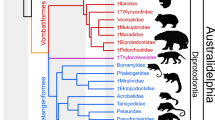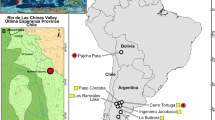Abstract
Fossils from a newly discovered, probably middle Eocene locality in southern Algeria provide the first evidence of an African terrestrial mesosuchian crocodilian with a ziphodont dentition (that is, with compressed, serrated teeth). Ziphodont mesosuchians were previously known mainly from South America and Europe, but have not been reported from North America. Several other groups of land vertebrates show a disjunct distribution in the Palaeogene, with representatives in Europe and South America, but no certain record in North America, where they should occur if, as has been suggested, dispersal had taken place from South America to Europe across North America. The discovery of a ziphodont mesosuchian in Algeria is the first tangible evidence that may support the alternative hypothesis of faunal connections between South America and Europe via Africa.
This is a preview of subscription content, access via your institution
Access options
Subscribe to this journal
Receive 51 print issues and online access
$199.00 per year
only $3.90 per issue
Buy this article
- Purchase on Springer Link
- Instant access to full article PDF
Prices may be subject to local taxes which are calculated during checkout
Similar content being viewed by others
References
Price, L. I. Notas prelim. Estud. Div. Geol. Miner. Bras. 25, 1–8 (1945).
Colbert, E. H. Bull. Am. Mus. nat. Hist. 87, 221–270 (1946).
Buffetaut, E. Geobios 9, 143–198 (1976).
Buffetaut, E. & Taquet, P. Bull. Soc. géol. Fr. 21, 183–188 (1979).
Berg, D. E. Abh. hess. Landesamt. Bodenforsch. 52, 1–105 (1966).
Antunes, M. T. Communções Servs geol. Port. 59, 285–330 (1975).
Rage, J. C. Cretaceous Res. 2, 65–84 (1981).
Mourer-Chauviré, C. Geobios 14, 5, 637–646 (1981).
Storch, G. Senckenberg. leth. 61, 3/6, 247–289 (1981).
Buffetaut, E. Annals Paléont. (Vertébrés) 66, 1–18 (1980).
Buffetaut, E. & Rage, J. C. Geobios 15, 267–269 (1982).
Rage, J. C. C.r. somm. Séanc. Soc. géol. Fr. 6, 281–285 (1978).
Crochet, J. Y. C.r. hebd. Séanc. Acad. Sci. Paris D 288, 1457–1460 (1979).
Mourer-Chauviré, C. Geobios 15, 268–269 (1982).
Cappetta, H. et al. Geobios, 11, 2, 257–263 (1978).
Author information
Authors and Affiliations
Rights and permissions
About this article
Cite this article
Buffetaut, E. A ziphodont mesosuchian crocodile from the Eocene of Algeria and its implications for vertebrate dispersal. Nature 300, 176–178 (1982). https://doi.org/10.1038/300176a0
Received:
Accepted:
Issue Date:
DOI: https://doi.org/10.1038/300176a0
This article is cited by
-
A small Cretaceous crocodyliform in a dinosaur nesting ground and the origin of sebecids
Scientific Reports (2020)
-
African marsupials—vicariance or dispersion?
Nature (1984)
-
Die altterti�re S�ugetierfauna von Messel ? ein pal�obiogeographisches Puzzle
Naturwissenschaften (1984)
Comments
By submitting a comment you agree to abide by our Terms and Community Guidelines. If you find something abusive or that does not comply with our terms or guidelines please flag it as inappropriate.



